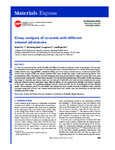Creep analysis of concrete with different mineral admixtures
| dc.contributor.author | He, Z | |
| dc.contributor.author | Qian, C | |
| dc.contributor.author | Li, Long-yuan | |
| dc.contributor.author | Du, S | |
| dc.date.accessioned | 2021-09-20T12:22:33Z | |
| dc.date.available | 2021-09-20T12:22:33Z | |
| dc.date.issued | 2016-08-01 | |
| dc.identifier.issn | 2158-5849 | |
| dc.identifier.issn | 2158-5857 | |
| dc.identifier.uri | http://hdl.handle.net/10026.1/17859 | |
| dc.description.abstract |
In order to comprehensively master the effect of different mineral admixtures on the creep behavior of concrete, the mechanical properties and creep of concrete with active mineral admixtures (i.e., fly ash (FA), ground granulated blast-furnace slag (GGBS), metakaolin (MK)) and inert mineral admixtures (i.e., limestone powder (LP), quartz sand powder (QSP) and emery powder (EP)) were studied by using a self-made testing device. The corresponding effect mechanism was also analyzed according to the internal relative humidity (IRH) and pore microstructure organization of the mixed concrete. The results show that the use of FA and/or GGBS can reduce the creep of concrete, and more creep can be reduced if both MK and inert mineral admixtures are used, although different mineral admixtures have different effects on the compressive strength and elastic modulus of the mixed concrete. The correlation between specific creep and IRH can be characterized in three different zones. The combined use of FA and GGBS can reduce the pore volume of pores of different sizes, and the concrete mixes with MK and inert mineral admixtures have very similar pore size distribution to provide more resistance to their creep. | |
| dc.format.extent | 328-336 | |
| dc.language | en | |
| dc.language.iso | en | |
| dc.publisher | American Scientific Publishers | |
| dc.subject | Creep | |
| dc.subject | Concrete | |
| dc.subject | Mineral Admixture | |
| dc.subject | Compressive Strength | |
| dc.subject | Elastic Modulus | |
| dc.title | Creep analysis of concrete with different mineral admixtures | |
| dc.type | journal-article | |
| dc.type | Journal Article | |
| plymouth.author-url | https://www.webofscience.com/api/gateway?GWVersion=2&SrcApp=PARTNER_APP&SrcAuth=LinksAMR&KeyUT=WOS:000386526600004&DestLinkType=FullRecord&DestApp=ALL_WOS&UsrCustomerID=11bb513d99f797142bcfeffcc58ea008 | |
| plymouth.issue | 4 | |
| plymouth.volume | 6 | |
| plymouth.publication-status | Published | |
| plymouth.journal | Materials Express | |
| dc.identifier.doi | 10.1166/mex.2016.1319 | |
| plymouth.organisational-group | /Plymouth | |
| plymouth.organisational-group | /Plymouth/Faculty of Science and Engineering | |
| plymouth.organisational-group | /Plymouth/Faculty of Science and Engineering/School of Engineering, Computing and Mathematics | |
| plymouth.organisational-group | /Plymouth/REF 2021 Researchers by UoA | |
| plymouth.organisational-group | /Plymouth/REF 2021 Researchers by UoA/UoA12 Engineering | |
| plymouth.organisational-group | /Plymouth/Research Groups | |
| plymouth.organisational-group | /Plymouth/Research Groups/Marine Institute | |
| plymouth.organisational-group | /Plymouth/Users by role | |
| plymouth.organisational-group | /Plymouth/Users by role/Academics | |
| dcterms.dateAccepted | 2016-07-01 | |
| dc.rights.embargodate | 2021-9-21 | |
| dc.identifier.eissn | 2158-5857 | |
| dc.rights.embargoperiod | Not known | |
| rioxxterms.versionofrecord | 10.1166/mex.2016.1319 | |
| rioxxterms.licenseref.uri | http://www.rioxx.net/licenses/all-rights-reserved | |
| rioxxterms.licenseref.startdate | 2016-08-01 | |
| rioxxterms.type | Journal Article/Review |


